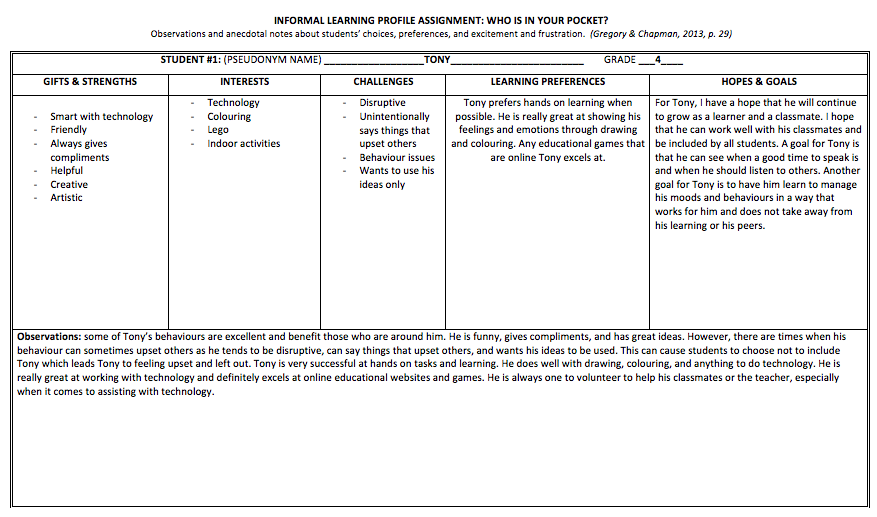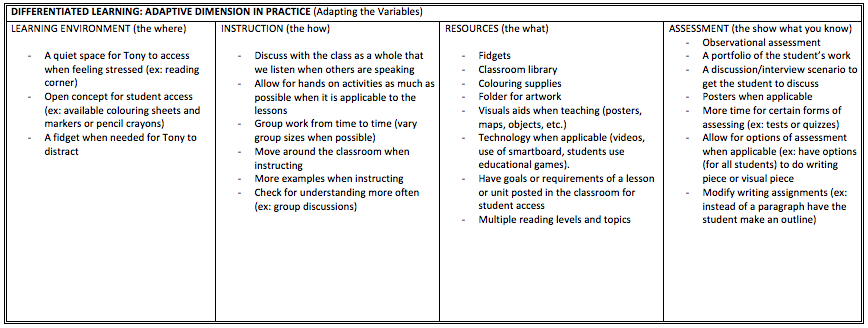Author: pnd909 (Page 1 of 3)
Tony is a grade 4 student. Tony loves technology, drawing and colouring, and building with lego. He is a smart and kind child who always brightens up the room with his personality and great ideas. He frequently gives compliments to his teachers and peers and is always willing to help anyone when it is needed. Tony also has a learning disorder and behavior issues. It is sometimes difficult for Tony to manage his emotions and can say things that may not be appropriate to the situation. This causes other children to target Tony and often times Tony is left feeling sad and left out. However, despite this Tony is always ready to participate in group activities. But there are times when Tony needs his space. There are times when Tony likes to share his ideas with the whole group and times when Tony chooses to keep all his work private. Tony’s parents are also separated. This also adds to Tony’s stress. Because of this, Tony often times can be disruptive and talk over top of other students. He also pushes his ideas onto other people in hopes that that is what everyone will do.
Tony really enjoys colouring to relieve his stress. He is also a fan of video games such as Fortnite. Tony also often plays educational games online. Tony can sometimes act out which causes the class to lose focus. Because of this there have been a couple times when Tony has been sent home from school based on his behavior. This also causes Tony to feel left out and sad. There are a few strategies with Tony that have worked to help him manage his behavior. First, asking Tony how his day was to see how is feeling that day makes him feel wanted and is a way for the teacher to know how he is feeling. When Tony is feeling upset or stressed, that is when more independent activities work for Tony such as colouring, building with blocks, or minimal partner work. When Tony is feeling happy and relaxed, he enjoys group work and sharing his ideas with others. Something that could benefit Tony is having a short one on one discussion about how his day is going and give him positive words. Also, role playing and having situations when other students are in charge and are choosing what happens may be beneficial for Tony to see other people’s ideas.


Throughout elementary and high school, I was never one who excelled at math but I also didn’t fail at math either. I was average at it. I really disliked math because I felt that I wasn’t very good at it. That being said, I can’t think of a time in any math class that was oppressive or discriminating. However, math was very by the book. There was always an emphasis on showing your work as you did it. Math always seemed to just be taught a certain way. I always thought there was not more ways to teach math or to even incorporate different things into a math class. Also, myself and a few others were always the students who needed extra explanation on a math concept. Other students understood and grasped the concepts right away. Throughout my whole schooling all my math teachers were very helpful and spent time helping us understand before, during, or after class. It didn’t matter the level everyone was at; the teachers took time to help everyone out.
Three ways that Inuit mathematics challenges Eurocentric ideas about mathematic purposes and the way it is learnt are counting, measuring, and localization. With counting, Inuit children learn to count in their language and then later will be taught English or French and will learn mathematics in that language they will be learning. Inuit children learn their numbers orally and do not have symbols for their numbers. With measuring, the Inuit people use body parts for measurement purposes versus devices to measure things. Also, the Inuit used a different calendar, their traditional calendar. This traditional calendar is not like a typical calendar with months named like May, June, July, etc. This traditional calendar goes off of natural events that occur annually in nature. As discussed in the article, one example of this is that the month of May would be “when baby caribou are born” (pg.61). Localization refers to “the exploration of one’s spatial environment and the symbolization of that environment with the help of models, diagrams, drawings, words, or other means” (pg. 56).
Reference: https://link.springer.com/content/pdf/10.1080%2F14926150709556720.pdf
I grew up in a small town in a white, Catholic family. I was with the same 17 people I graduated with from Kindergarten to Grade 12. So, I think of my upbringing and schooling as very different from others. In my school, there was limited clubs and sports for students and therefore, there was a definite hierarchy. Classes were often divided between the hockey players and the non-hockey players. In fact, I never knew until I was in my first year of university that high schools in bigger cities had a school band. That being said, there was also a lack of diversity in my school. Almost all students were white, there was very little to no students with disability, and content (in younger grades) was generally based on white, heterosexual characters. In high school, our content was slightly more diverse. But, the books we read about other cultures and races were limited. We got a few elders and residential school survivors to speak to our school. There were also many other groups that came in to talk about cultural diversity. But, while we did discuss different cultures and races, we did not talk about LGBTQ or disabilities.
My eyes were opened when I began attending the University of Regina. I have learned so much about things that I never had the opportunity to learn or experience in my small-town school. Ever since taking education classes at the University I have been taking steps to understand more about things I never experienced before. As a teacher, I will work to not let what I grew up around influence how I will teach my students. I will always question and challenge any biases I may have in my life and that is part of how I can work against them. I have learned so much and will continue to learn so I can work to be the best teacher I can be.
According the Levin, school curricula is developed through various policies which “govern every aspect of education” (Levin, 2008). This makes sense that policies would contribute to the development and implementation of curricula. Something I found interesting that Levin stated is that most times decisions in regards to curriculum are made with very little to no public knowledge. I found this interesting because the people whose children are learning should be aware of changes that are made to the curriculum, whether it is a small change or not. So, decisions and changes made about curricula are primarily made by the government. Also, curriculum is developed about “very general or broad goals and then much more specific learning activities and objectives” (Levin, 2008). In the article, it is discussed how postsecondary schools can have “powerful influence on school curriculum” (Levin, 2008). To me, this means that postsecondary schools have certain requirements for each program and therefore are looking for certain things from future students. So, it makes sense that postsecondary schools would have such an influence on curriculum since students want to learn things that will benefit the future schooling and have them qualify for those schools.
The first connection I made from the article and the implementation of Treaty Education in Saskatchewan is that since all these curriculum decisions basically come from the government, it could be possible that the implementation of treaty education could be overlooked. Meaning, it has only been in recent education time that treaty education has begun to be implemented and many people still do not fully understand it. That being said, for teachers it can be difficult to teach about it if they do not have a strong understanding. I also think that no matter what decisions are made in regards to this, not everyone is going to have the same opinions and agree on everything. I think that it is a teacher’s job to do the best job they can on educating young people about treaty education because it is a part of our history and we live on treaty land. It is also up to the government to create curriculums that will best benefit the student and their learning as well as recognizing our country’s past and future.